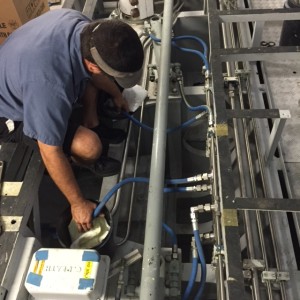 Every system on a mega yacht is important to the overall comfort and safety of the vessel and vessel’s using hydraulics are no exception. So how often should a hydraulic system, like those used for the steering, stabilizers, bow thrusters or windlass operations be flushed? To be on the safe side, a sample of the hydraulic fluids should be tested every six to 12 months or whenever the system is opened and potentially exposed to outside contaminants, you suspect that water may have infiltrated the tank or metal particles are found in the oil.
Every system on a mega yacht is important to the overall comfort and safety of the vessel and vessel’s using hydraulics are no exception. So how often should a hydraulic system, like those used for the steering, stabilizers, bow thrusters or windlass operations be flushed? To be on the safe side, a sample of the hydraulic fluids should be tested every six to 12 months or whenever the system is opened and potentially exposed to outside contaminants, you suspect that water may have infiltrated the tank or metal particles are found in the oil.
There are three methods for flushing a hydraulic system. The first is a simple drain, filter, fill approach referred to in our shop as a DFF. This type of flush is actual more of an “oil change” and is typically recommended for routine maintenance. It is not appropriate where a more serious condition such as water, metal particles or other contaminants are found in the oil. In this scenario, we would drain the hydraulic tank, change out the filters and refill the tank with hydraulic fluid. Pretty straight forward.
The second method, known as a double oil and filter change, requires us to drain the hydraulic tank and fill with fresh oil that will be circulated using on-board system pumps. This method would be suggested under a few conditions; many years since last oil change, requirement to change oil types, minor discoloration of oil, etc. This method involves an initial oil drain from the tank and low points in the system and filter change which can expel a large percentage of contaminants and degraded fluid. We would then fill the tank to the minimum level allowable to still safely work and circulate the oil until operating temperature is achieved. The oil is drained again and the filters changed for a second time before re-filling the hydraulic tank with fluid. For best results, the system should be drained as thoroughly as possible including the tank and manually cleaned.
The last option is more time consuming and costly and is used when there is known contamination of water or metal particles. This method often uses special high pressure pumps or power flushing rigs. Some of these pumps or rigs have directional valves that enable flushing direction to be changed which can assist in dislodging contaminants from dead spaces throughout the system. As in previous methods, the first step is to drain all old hydraulic fluid from the system and refill with a low viscosity fluid that will be circulated at high velocities to create turbulent flow conditions that equate to a Reynolds number of more than 2,000. This process would be repeated as needed until there is no longer any contaminants present in the filters or fluid. We would also remove, inspect and when necessary replace any hoses, cylinders and valves that are damaged.
Just like changing the oil in your car or any other mechanical device, hydraulic systems on your yacht need care and attention to keep them performing in peak conditions for years to come.




